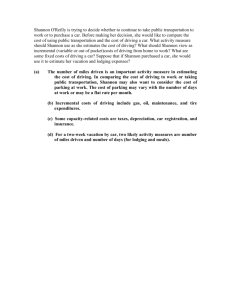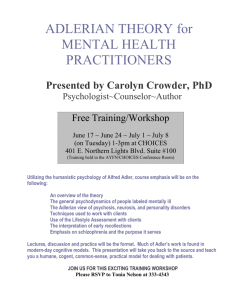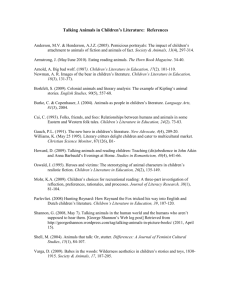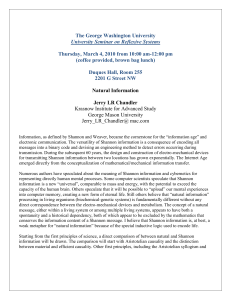Template Theories Field Assignment 2
advertisement
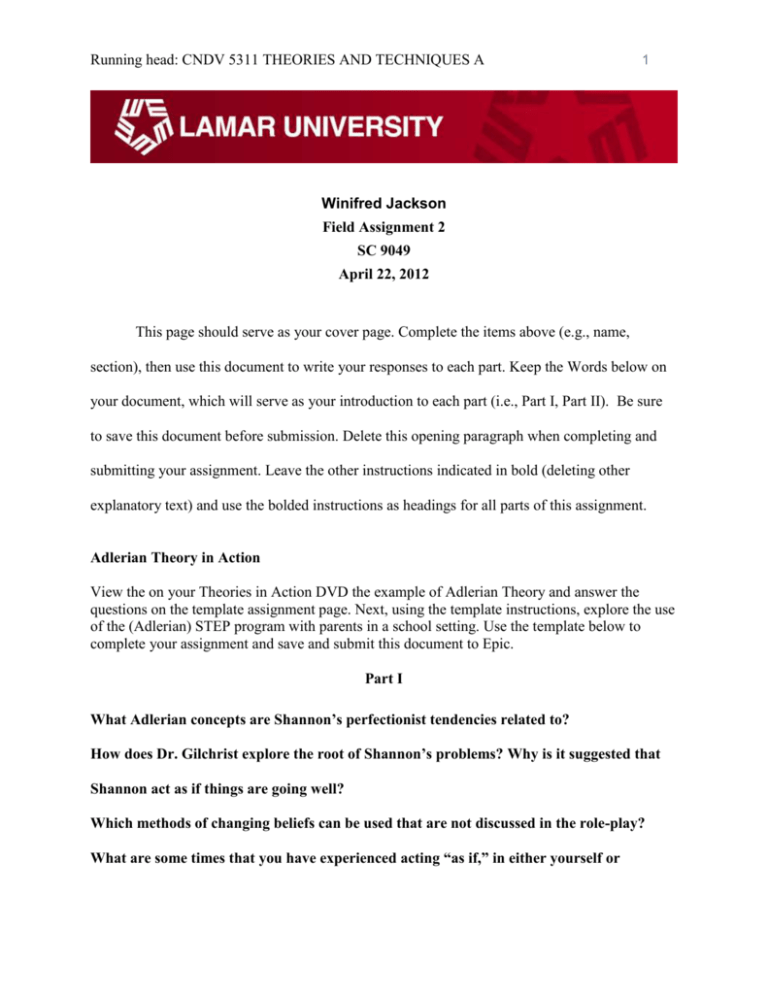
Running head: CNDV 5311 THEORIES AND TECHNIQUES A 1 Winifred Jackson Field Assignment 2 SC 9049 April 22, 2012 This page should serve as your cover page. Complete the items above (e.g., name, section), then use this document to write your responses to each part. Keep the Words below on your document, which will serve as your introduction to each part (i.e., Part I, Part II). Be sure to save this document before submission. Delete this opening paragraph when completing and submitting your assignment. Leave the other instructions indicated in bold (deleting other explanatory text) and use the bolded instructions as headings for all parts of this assignment. Adlerian Theory in Action View the on your Theories in Action DVD the example of Adlerian Theory and answer the questions on the template assignment page. Next, using the template instructions, explore the use of the (Adlerian) STEP program with parents in a school setting. Use the template below to complete your assignment and save and submit this document to Epic. Part I What Adlerian concepts are Shannon’s perfectionist tendencies related to? How does Dr. Gilchrist explore the root of Shannon’s problems? Why is it suggested that Shannon act as if things are going well? Which methods of changing beliefs can be used that are not discussed in the role-play? What are some times that you have experienced acting “as if,” in either yourself or CNDV 5311 COUNSELING THEORIES AND TECHNIQUES A 2 someone you know? How might this technique instill hope that change is possible and “reconstruct” someone’s understanding? Shannon’s perfectionist tendencies related to Adlerian concepts about early recollection and family constellations. “Adler believes that the style of life was developed in early childhood allowing children to strive for perfection or superiority” (Sharf, 2012). This style of life determined how Shannon adapted to obstacles in her life from early childhood, such as living with an alcoholic father, living through her parents’ divorce, and protecting of her younger brother. Shannon’s birth order had an impact on how her role was perceived in her family. As the oldest child, Shannon tends to be responsible, strives for perfectionism, and attempts to make her parents proud of her. According to Sharf (2012), “Perceived role in the family was more important to Adler than actual birth order itself. Adlerians are often critical of birth order research that looks only at position in the family.” Dr. Gilchrist asked Shannon about how long she had been feeling overwhelmed and stressed out about all directions her life was taking her. Dr. Gilchrist asked Shannon to explore her early recollections by discussing her childhood. Then she related Shannon’s problem to her early recollection from childhood. Shannon recalled some memories of helping her mother around the house with cooking dinner, doing the dishes, watching her young brother, staying inside with him by not going to while her friends played in park. Dr. Gilchrist used empathy to related Shannon’s problem to her early recollections and memories. Dr. Gilchrist refocused the client to thinking about herself by asking her to discuss what she had done for herself. Dr. Gilchrist used empathy to show Shannon how her perfectionism equal stress. Dr. Gilchrist asked Shannon to act as if she was still the hard worker with high expectations to help her change her action and to reduce stress. She wanted Shannon to recognize it was fine not to be a perfectionist. This technique helps the patient take an action she 2011 Lamar CNDV 5311 COUNSELING THEORIES AND TECHNIQUES A 3 may be afraid will fail by trying a new behavior to develop a new feeling of confident. If the action is unsuccessful, the counselor will explore what interfered with the new experience to encourage a new behavior. I believe the “catching oneself” method could be used to help Shannon change her belief in the role-play. This method tries to get the patient to “catch themselves” doing behavior they want to change when they repeatedly perform that act. Dr. Gilchrist might suggest that Shannon document on a chart every time she use her perfectionism. I have had the experience of acting as if I did not have to be in control of organizing an event. I like to organize our family reunions every year and think all the responsibility lies on me to get the invitation distributed to everyone, organization the activities, coming up with the theme, and designing the t-shirts. I have learned the last few years that my children can help me with the planning of the family reunion by listening to their ideas. At first it was hard for me not to be in charge of entire event, I watched me feeling comfort with the activities my children organized last year with success of everyone participating in all the activities. This technique can give a patient a relatively simple task to follow through to help change the patient’s action. Through creativity, a therapist can encourage the patient to take courage to change through role-playing. Part II (25 points each section for 50 points): Personal Style To complete Part II, Section 1 and 2, begin by exploring the website explaining Systematic Training for Effective Parenting (STEP): http://www.steppublishers.com/about Next, write a brief essay explaining in your own words, using references where appropriate (APA style guidelines), the use of Adlerian theory with parents. Specifically, address the following sections. Each section (Section 1 and Section 2) should be approximately one to two pages in length each. 2011 Lamar CNDV 5311 COUNSELING THEORIES AND TECHNIQUES A 4 SECTION 1: What is STEP? How is STEP useful for working with families and (a) children and (b) adolescents? STEP is Systematic Training for Effective Parenting is a multimedia parenting education curriculum. The programs is a four steps to help parents learn effective ways to connect with their children from birth through adolescence by using parent education study groups in 8 to 9 weeks for 1.5 hours. . The study groups use the kit to help improve: 1. Child behavior 2. Parent potential to physically abuse child 3. General family functioning 4. Parenting stress 5. Parent-child interaction. “Although STEP was designed for use with parents facing typical parenting challenges, all the studies target families with an abusive parent, families at risk for parenting problems and child maltreatment, or families with a child receiving mental health treatment.” (National Registry of Evidence-Based Programs, 2010). By identifying the intention of children's behavior, the curriculum helps parents learn how to encourage cooperative behavior in their children and how not to reinforce unacceptable behaviors. The multimedia program helps parents change dysfunctional and destructive relationships with their children by offering concrete alternatives to abusive and ineffective methods of discipline and control. It is presented in four separate programs covering early childhood, children ages seven through twelve, and teenagers. Each program includes a leader's resource guide, promotional tools, videos and parent handbooks. STEP is embedded in Adlerian psychology and promotes a more participatory family structure by nurturing responsibility, independence, and competence in children; improving communication between parents and children; and helping children learn from the natural and logical consequences of their own choices. It has been implemented in over a 1,000 schools, agencies, and mental health facilities to help children and adults in handling family relationships, social functions, mental health, and violence. 2011 Lamar CNDV 5311 COUNSELING THEORIES AND TECHNIQUES A 5 SECTION 2: The following page presents a session from the Step Program, specifically, Session 4, which is the worksheet directly following this assignment. After reviewing this worksheet, write a one to two-page reflection explaining: How is the concept of encouragement related to superiority? How is the concept of encouragement related to social interest? In what ways do choices impact the relationship between parent(s) and children? Dinkmeyer suggested the parents use the I-message when communicating with their children to describe how the parent feels about a particular behavior. By using respectful words it encourages positive behavior from the child. He suggests making a list of each child’s strength to keep in your wallet to help the parent understand that each child is unique and different. This assists the parent in recognizing that each child may act or react different and to build a relationship with each child. The goal is to help children understand and recognize that choices begin with the parent. When parents help the child identify the goals, the parent helps the child decide who owns the problem through their questioning techniques. The parent should use reflective listening to help create a two-way communicate between the parent and the child. When the parent communicate to the child positive behavior that has been observed, the child begin to understand what the parent expect in a respectful manner. This begin to develop a positive relationship between parent and child. Adlerians attempt to establish a relationship of respect and mutual trust with the client to develop goals. Adler believes encouragement is useful in building relationship and in assessing the action for change. By focusing on the child’s strengths, it encourages the child to take risks and his willingness try new things. “Although the desire to overcome inferiority and achieve superiority or mastery is normal in individuals and a major goal of life” (Sharf, 2012), children need to understand their perceived family role to help them recognize their self-importance to overcome inferiority feelings. Relationship is the first process in Adler theory, and STEP goal is to help children understand the cause and effect relationship between their decisions. By assessing the child strengths it begins the relationship building in the lifestyle of the child. “Because family constellations, early recollections, dreams, and basic mistake often lead to finding out what is the wrong with the person, it is helpful to look 2011 Lamar CNDV 5311 COUNSELING THEORIES AND TECHNIQUES A 6 at what is right (Sharf, 2010)(Watts & Pietrzak, 2000). Assets are not also obvious with each child the list will help the parent recognize each child uniqueness. When parent show empathy with their children, the child is willing to try a different behavior. References: Sharf, R. S. (2012). Theories of psychotherapy. (6th ed.). Pacific Grove, CA: Thomson Brooks/Cole. Chapter 4. Systematic Training for Effective Parenting (STEP). (2010, January). Retrieved April 22, 2012, from NREPP SAMHSA'S National Registry of Evidence -based Programs and Practice: http://www.nrepp.samhsa.gov/ViewIntervention.aspx?id=132 2011 Lamar CNDV 5311 COUNSELING THEORIES AND TECHNIQUES A 7 Parenting – Based on Systematic Training for Effective Parenting (Dinkmeyer) Doing Something Different “Encouragement” Decide to change. Change your purpose. Do I want to give attention, or help my child be self-reliant? Do I want to show who’s the boss, or help my child be independent and reasonable? Do I want to get even, or show that I understand? Do I want to let my child off the hook, or teach my child courage? Change your beliefs and feelings. You don’t need to feel angry with your child. Ask yourself – “Am I annoyed? Angry? Or am I committed to helping my child change his or her behavior?” A Philosophy of Parenting – Beginning With the End in Mind 1. Children learn through the family Norms versus rules Consequences versus control 2. Individual learning is enhanced through involvement with real problems Point out the choices available to your child Expect your child to make mistakes 3. Individual learning can be enhanced through experiential learning What is going on here? So what? Now what? Then what? 4. Encourage your child Catch them doing something right Make a list of the strengths of each of your children and keep it in your wallet Do the positive list activity as a family, or one on one with each child. Empathy versus sympathy 2011 Lamar

